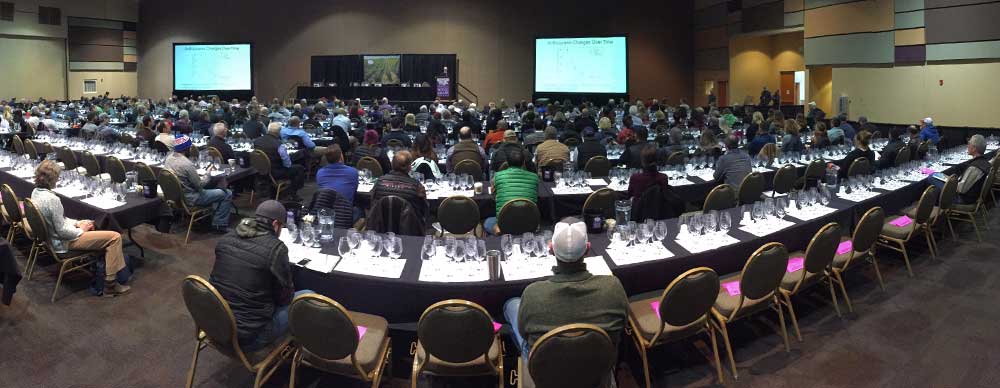
Speakers address Washington Winegrower attendees during the morning sessions covering the state’s climate and geology on Feb. 9, 2017. (TJ Mullinax/Good Fruit Grower)
It’s taken for granted that everyone attending the Washington Winegrowers meeting in Kennewick, Washington believes in the state’s wine industry. But what really makes the region unique was the subject of a Thursday session.
The geology and climate both set the stage for high quality wine grape production. Although which matters most depends on whether you ask a geologist or a viticulturist.
Kevin Pogue, a geology professor at Whitman College in Walla Walla, said Washington’s viticultural area is unique because it’s the largest area in the world where grapes are planted in fine, sandy wind-deposited soils. These sandy soils are well suited to deficit irrigation and appear to be relatively resistant to phylloxera, Pogue said.
Following Pogue, Washington State University viticulturist Markus Keller argued that the region’s growing climate is far more important than its soils. Compared to other wine regions around the global, Eastern Washington’s temperature (measured by growing degree days accumulated) is in the middle of the pack.
Keller said that best feature of the climate in Eastern Washington is actually what the region lacks: rainfall.
The dry, sunny conditions lower disease pressure and offer growers more control over vineyards through irrigation practices. And winter climate matters too, Keller said. In Washington, it gets cold enough to limit many insect pests but not too cold to cause frequent vine damage.
He ended his talk with a photo of Armenia, where the world’s oldest winery was located. The landscape looks just like Eastern Washington, he said. And it’s that dry, sunny landscape that matters, more than latitude comparisons to iconic European wine regions.
“It’s not the latitude,” Keller said. “It’s the combination of optimum temperatures and the lack of rainfall that allows us to deficit irrigation.”
Lastly, the warm days and cool nights common in the region favors malic acid retention in the fruit, said WSU winemaker Jim Harbertson.
Another session focused on mechanization in vineyards. Ed Hellman, professor of viticulture at Texas Tech University, offered some insights into a still-to-be completed study on the economics of mechanization. (Good Fruit Grower reported on the early study results, The Costs of Vineyard Labor, in the May 1, 2016 issue.)
Overall, Hellman said, autonomous tractor and equipment operations are likely the “low-hanging fruit’ of mechanization that are most likely to occur next, followed by some hand-harvest assist operations, such autonomous fruit movers, and catch wire movement operations.
Richard Hoff, director of viticulture for Mercer Canyons, talked about the company’s efforts to mechanize vineyard operations.
Following a 2015 trial, comparing two different treatments of mechanization to a control block, Hoff concluded that the mechanical desuckering machine employed was inefficient and that over the top thinning was too aggressive for future bud positions.
Since those results, Hoff is now doing just one pass with the shoot thinner and only hitting sides of the cordon or coming from the bottom, “now more of a scrubbing operation.”
Ultimately, Hoff and the winemakers also compared the wines produced form those three blocks, with few differences noted, he said. All probably would be sold in the same price tier, he said.
– by Shannon Dininny and Kate Prengaman






Leave A Comment